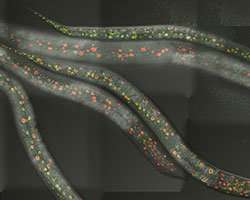Breakthrough article on mechanistic features of microRNA targeting and activity

Giovanna Brancati and Helge Grosshans from the FMI have described target specialization of miRNAs of the let-7 family. They identified target site features that determine specificity, and revealed that specificity can be modulated in a manner that allows cells to integrate target site quality and miRNA abundance. Their findings address the unresolved question of how miRNA family members can be targeting different transcripts within the same cell.
A dogma in the miRNA field has been that the so-called miRNA 'seed' (5') region suffices for target silencing and that, therefore, 'miRNA sisters' function redundantly because they share a seed sequence. However, this view has recently been challenged through experimental target capture, which indicated extensive specialization of individual miRNA family members through seed-distal (miRNA 3' end) pairing.
In their studies published in Nucleic Acids Research (NAR), the investigators determined experimentally features that govern specialization of members of the let-7 family, which are popular model miRNAs with important functions in development and tumorigenesis. Through in vivo studies in C. elegans, they found that extensive seed-distal pairing promotes specificity, but that the extent of specificity is modest, and insufficient to support robust development, unless target sites also contain an imperfect seed match. Their studies go on to reveal that different target site architectures require different miRNA concentrations for silencing. This challenges a model of 'one size fits all', where at a given concentration, a miRNA is either on or off, across all targets. Instead, it supports a rheostat model, where binding site quality and miRNA abundance are integrated into a silencing outcome unique for each target.
Reviewers and editors familiar with the work have stated that the study "is a major contribution piece for the miRNA field" that provides "a convincing set of data that addresses the unresolved question of how miRNA family members can be targeting different transcripts within the same cell", that its "findings are extremely important for the field and exemplify the importance of studying miRNAs and their targets in endogenous contexts" and that the paper "will serve as an important reference for this phenomenon that is likely a prevalent feature of miRNA-mediated gene regulation." They go on to state that "Conceptually, the idea of graded contributions of miRNA paralogs... is also very unique. It is a break from the prevailing but too simplistic view that miRNAs are redundant for as long as they share the seed... and show the importance of deviations from canonical sites (G:U wobble, mismatches etc) for the function of specific miRNAs."
NAR's Breakthrough Articles present high-impact studies answering long-standing questions in the field of nucleic acids research and/or opening up new areas and mechanistic hypotheses for investigation. These articles are chosen by the Editors on the recommendation of Editorial Board Members and Referees. They represent the very best papers published at NAR.
More information: Giovanna Brancati et al. An interplay of miRNA abundance and target site architecture determines miRNA activity and specificity, Nucleic Acids Research (2018). DOI: 10.1093/nar/gky201


















